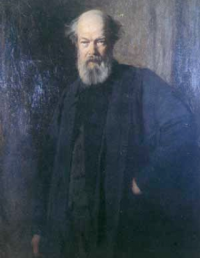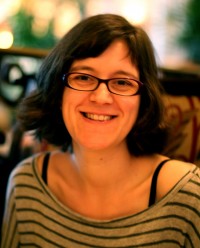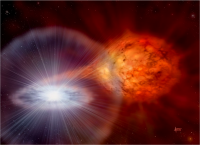
Up to 15 fully-funded Prize PhD Studentships and over 100 other funded PhD places available in Physics in Scotland.
The Scottish Universities Physics Alliance (SUPA) opens a single door into all Physics PhDs in Scotland. When you apply for a SUPA Prize PhD Studentship, you will also be considered for all other funded places available in Physics departments in Scotland.
Themes
Major themes pursued by researchers in SUPA are:
- Astronomy and Space Physics
- Condensed Matter and Material Physics
- Energy
- Nuclear and Plasma Physics
- Particle Physics
- Photonics
- Physics and Life Sciences
Eligibility
All Physics PhD students in Scotland are considered SUPA Graduate School students and are eligible to attend all educational and training activities.
Deadline
Applications must be made by 31st January 2013.

Senior Honours student Alex Williams' project has been published in leading journal Physical Review.
His paper "Paramagnetic and glass transitions in sudoku" involved a study of the statistical mechanics of a model glassy system based on sudoku. Defining an energy and temperature based on the number of errors on a sudoku grid, Alex used methods devised at Los Alamos in the Manhattan project to reveal similarities between properties of sudoku puzzles and magnetic systems.
The “sudoku Hamiltonian” exhibits two transitions as a function of temperature: a paramagnetic and a glass transition. Of these, both transitions are associated with an entropy change. Paramagnetism measured from the dynamics of the Monte Carlo run shows a peak in specific heat, while the residual glass entropy is determined by finding multiple instances of the glass by repeated annealing.
There are relatively few such simple models for frustrated or glassy systems that exhibit both ordering and glass transitions; sudoku puzzles are unique for the ease with which they can be obtained, with the proof of the existence of a unique ground state via the satisfiability of all constraints. Simulations suggest that in the glass phase there is an increase in information entropy with lowering temperature. In fact, we have shown that sudoku puzzles have the type of rugged energy landscape with multiple minima that typifies glasses in many physical systems.
Alex's code also solves sudoku puzzles.

Researchers from the Institute for Condensed Matter & Complex Systems have published a paper in Physical Review Letters which sheds light on how bacteria can become resistant to antibiotics very rapidly in some environments, but not in others.
The emergence of disease-causing bacteria which are resistant to known antibiotics is one of the most important current global health challenges. Drug-resistant "superbugs" kill thousands of people in the UK every year. This is a growing problem, because new antibiotics are not being discovered fast enough to keep up with the rate of evolution of resistance.
Theoretical model
Using a simple theoretical model of a bacterial population which expands to colonize a new territory, Philip Greulich, Bartlomiej Waclaw and Rosalind Allen show that a non-uniform concentration of antibiotic can greatly speed up the evolution of resistance, compared to the case where the drug is evenly distributed. Non-uniform drug distributions are expected to be very common: for example, drugs in our body accumulate to different levels in different organs. Importantly, the speedup in evolution of resistance that is predicted by the model depends on the sequence of genetic mutations by which the bacteria become drug resistant. It only happens if all the mutations along the pathway increase the drug resistance. Unfortunately, this seems to be the case for many commonly-used antibiotics.
This research shows that simple, statistical physics models can provide important insights into biological problems. The theory developed by the Edinburgh researchers may also be relevant to the evolution of cancer cells resistant to chemotherapeutic drugs, suggesting that the highly non-uniform microenvironments found inside tumours may present a major obstacle to the successful treatment of the tumour before drug resistance emerges.
Image gallery

The Tait Medal is awarded to the best final year students in Mathematical Physics or Mathematics & Physics. This year's winners are Alastair Heffernan, Vladimir Prochazka and Mara Ungureanu. Our congratulations to all three winners.
"This year there were three excellent candidates, all with excellent results, so we decided to give them a medal each. This is very unusual: it last happened in 1979." Richard Ball, Professor of Mathematical Physics
Tait Institute
The Tait Institute is devoted to teaching and research in mathematical physics. Founded by Nick Kemmer in 1955 in honour of Peter Guthrie Tait, it was re-established in 2011 as the focus for mathematical physics in Scotland.
The members of the Tait Institute teach a range of undergraduate degrees in Mathematical Physics. Research covers a wide range of areas: from string theory and cosmology to particle physics, statistical mechanics and high performance computing.
The Tait Institute supports international visitor, workshop and summer school programmes in conjunction with SUPA and SUSSP. Annually, it hosts the Robin Schlapp Lecture, given by some of the most distinguished mathematical physicists in the world.
Image gallery

Alexander McVey, a post-graduate student based in COSMIC (the School's Collaborative Optical Spectroscopy Micromanipulation & Imaging Centre), received second prize for his presentation of preliminary results from his PhD research, which is investigating the mechanisms behind the development of drug resistance in bacteria such as E. coli.
At the conference, Alexander's group also presented the results of the optimisation of its CARS system (coherent anti-Stokes Raman scattering), using polystyrene beads and the preliminary results of E. coli samples.
Imaging bacteria
CARS is an innovative method of laser-based microscopy that was developed to study E. coli biofilm formation. It is a powerful, nonlinear optical imaging technique that uses the phenomenon of Raman scattering to specifically target a chemical bond within a sample to produce a light signal of different frequency to the incident laser beams. By targeting specific chemical bonds within the sample, the CARS method produces significantly less background signal than other laser microscopy methods, enhancing the quality of the image that can be obtained.
Alexander is currently working on developing CARS as a new method for imaging bacteria in a non-invasive fashion and without the need to introduce any external tags. As part of the effort to develop CARS, the group has been involved in a major new collaboration with Glasgow-based M Squared Lasers and the University's Division of Pathway Medicine.
INSPIRE
INSPIRE is a SUPA (Scottish Universities Physics Alliance) led initiative designed to promote collaboration between physics academia and industry in Scotland. INSPIRE aims to provide studentships, staff exchanges and networking events, where physics and life sciences meet. The scheme is funded by the Scottish Funding Council Horizon Fund.
At the INSPIRE conference, all current SUPA postgraduate students who are funded through the INSPIRE programme can present their work to date.
Image gallery

Elena Blanco of the School's Soft Matter Physics research group is investigating particle dispersion in chocolate making.
My background is in Soft Matter and I have previously worked on emulsion and foam stabilisation using surface-functionalised particles. The ability of colloidal particles to adhere to liquid-liquid or liquid-air interfaces is known as Pickering stabilisation. Pickering foams and emulsions can be remarkably stable to coalescence because of the high energies of attachment for particles held at fluid-fluid interfaces.
Complex colloids with chemically heterogeneous surface properties, unconventional shapes and morphologies play a key role in the stabilisation of foams and emulsions. Existing studies confirm that the particle layer at the fluid-fluid interface enhances Pickering stabilisation. For this reason, these colloids may be engineered to give new functionality to structured assemblies.
The science of chocolate
The project at Edinburgh is focused on understanding the properties of dense, complex dispersions of heterogeneous particles in heterogeneous fluids such as occur in the processing of chocolate.
Chocolate is a semi-solid suspension of solid particles (cocoa solids, sugar and milk proteins) dispersed in a fat continuous phase. Several factors may influence the physical and sensory properties of the final product. Chocolate has a continuous fat phase in which sugar cannot disperse, so natural surfactants like lecithin are used as emulsifiers.
Lecithin, a by-product of soya oil, is a mixture of phospholipids; their amphiphilic nature allows them to act as dispersants at the interface between hydrophilic components (such as sugar) and hydrophobic components (such as fat) to facilitate their mixing. Once the surfaces of the solid particles become coated with lecithin, the chocolate becomes more liquid-like.
Conching and rheology
Chocolate-making involves a process of mechanical agitation called conching that was developed by Rodolphe Lindt in 1879. Conching breaks agglomerates, coats the solid particles with fat and reduces the viscosity, so creating the desirable flow (rheological) properties of chocolate.
A well-defined texture is dependent upon these flow properties. Chocolate behaves as a non-Newtonian fluid presenting a yield stress (the minimum amount of stress that must be applied for flow to occur) and plastic viscosity. It is not well understood how the rheology of chocolate is affected by the interactions between the different components of chocolate and the process of conching.
Commercial application
Chocolate is a luxury food that, during consumption, evokes a range of stimuli which activate the pleasure centres of the human brain. The average consumption in many European countries is around 8kg per person per annum. This project, which is sponsored by Mars Chocolate, aims to use world-class scientific expertise to deliver top quality, pleasurable products.
In recognition of the theoretical work of Professor Peter Higgs, which led to the recent discovery of the Higgs boson and completion of the Standard Model of elementary particle physics, the University of Edinburgh is establishing the Higgs Centre for Theoretical Physics.
It will also establish a Chair in the name of Peter Higgs.
The Centre will bring together theoretical physicists from around the world to seek an even deeper understanding of how the Universe works.
The University has committed an initial sum of £750k for new academic staff, PhD studentships, and a programme of international visitors and workshops at the Centre, which will be based within refurbished space at the James Clerk Maxwell Building on the King’s Buildings campus.
“Discovery of the Higgs boson completes our picture of the known elementary particles, but these make up only 4% of the Universe. It demonstrates the power of theoretical physics to explain Nature, even though it took almost fifty years for the experimental confirmation. So we are confident that the work of the Higgs Centre can guide our search for what the rest of the Universe is made of.” Prof. Richard Kenway, Tait Professor of Mathematical Physics, University of Edinburgh
The Centre’s International Steering Committee will be chaired by Richard Kenway (Tait Professor of Mathematical Physics) and includes: Peter Higgs, John Ellis (Clerk Maxwell Professor of Theoretical Physics, King’s College, London) and James Stirling (Jacksonian Professor of Natural Philosophy, University of Cambridge). The Director will be Professor Richard Ball.
Higgs Centre for Theoretical Physics Fund
A campaign, known as the Higgs Centre for Theoretical Physics Fund, has been established to support the work of the Centre.
Donations can be made to the fund by contacting the Development and Alumni team on 0131 650 2240; emailing margaret.clift [at] ed.ac.uk or through the Higgs Centre for Theoretical Physics Fund website.
Image gallery

Scientists at Cern have announced results giving the strongest indication yet that the Higgs boson particle exists.
Newly analysed data from the underground facility near Geneva has discovered a new particle consistent with the Higgs boson, which was first postulated by the University’s Professor Peter Higgs.
"Scientists at Cern are to be congratulated on today’s results, which are a great achievement for the Large Hadron Collider and other experiments leading up to this." Professor Peter Higgs, Emeritus Professor, The University of Edinburgh
Tiny yet key particle
Professor Higgs developed his theory of the particle that bears his name when he was a researcher at the University in the early 1960s. Since then, the Higgs boson has formed a crucial strand of particle physics theory. It is thought to be a tiny yet key particle that enables all other particles to have mass.
Physical universe
The Higgs is a missing link in the standard model of physics, a theory that defines our understanding of the physical world. If the particle exists, it validates our understanding of fundamental physics.
"The efforts of our team at Edinburgh have helped make these results from Cern a reality. We are very proud to have contributed to these findings." Dr Victoria Martin, Lecturer, School of Physics and Astronomy
University input
Some 15 scientists from the University are involved in the research at Cern, including some whom were taught by Professor Higgs. The LHC smashes protons together at high energy, to recreate the conditions that existed just after the big bang.
Complex experiments
Under these conditions, Higgs bosons may be produced, but these decay almost as soon as they are formed. Scientists search instead for other particles left behind by the Higgs’ decay. For every billion proton collisions, about 1 Higgs bosons would expect to be seen - so scientists have to carry out myriad experiments and then dig deep into their data to find evidence of the particle.
"This is truly an exciting time and comes after many years of hard work." Dr Phil Clarke, Reader, School of Physics and Astronomy
Image gallery

Thomas Scheler, a PhD student in the Extreme Conditions group of the Institute for Condensed Matter, describes his placement at Edinburgh Instruments Ltd.
My appetite to find out more about working in industrial research was whetted by the industrial associates’ talks at last year’s careers event. This led to me taking a 7-week break from my PhD earlier this year, to work in the R&D division of Edinburgh Instruments Ltd, a medium‐sized company producing and developing, amongst other things, fluorescence spectrometers.
During my placement I was fully integrated into the daily routine and worked on developing benchmark tests for novel grating spectrometers – not dissimilar from the instruments I have been using in my PhD.
Commercial v. PhD
The differences from my PhD work that struck me were the shorter deadlines and consideration of consumer interests. Like other students, I am used to deadlines in my PhD for submitting conference abstracts, research proposals and project reports. I feel, however, that the potential consequences if I ever failed to meet these would largely be confined to me, whereas failing to meet a deadline in a company, such as delivering a product late, would be much more serious.
The focus of my work at Edinburgh Instruments was on someone else’s (ultimately a customer’s) project and delivering a fully working product, which contrasts with the longer term aims and greater freedom of my PhD. This meant spending much more time than I anticipated on user interfaces and ergonomics, things that might be considered a distraction from ‘the science’ in my PhD.
"The placement taught me a lot and I feel much better informed about the career decisions I will need to make. I strongly recommend a similar experience to other students." Thomas Scheler
I worked as part of a team of many highly-skilled individuals, most of whom had a university background, most with PhDs and some having completed postdoctoral positions before moving to industry. I enjoyed working in their team and appreciate how well integrated they made me feel. Previously, I had only experienced life in an academic environment and at national laboratories.
The Scottish Doctoral Training Centre in Condensed Matter Physics
Thomas is a student of The Scottish Doctoral Training Centre in Condensed Matter Physics, a tri-institutional collaboration between the universities of St Andrews, Edinburgh and Heriot-Watt that provides international-level doctoral training in the core discipline of condensed matter physics. It was established in December 2008 with generous funding from the UK Engineering and Physical Sciences Research Council and offers more than ten 4-year PhD fully funded studentships per annum. The first cohort of students arrived in September 2009.
Students perform a PhD research project, take graduate level courses, participate in summer schools, conferences and workshops, and receive skills training relevant to their future careers. The Centre aspires to produce rounded graduates equipped to succeed in research, academia and a wide range of industries and businesses.

In the latest issue of the prestigious Physical Review Letters journal, School nuclear physicists report on the measurement of a nuclear reaction that is key to the understanding of type I X-ray bursts.
X-ray bursts are among the most energetic explosions in the Universe. They are triggered by a thermonuclear runaway on the surface of a neutron star that is accreting hydrogen- and helium-rich material from a less evolved companion in binary star systems.
Type I X-ray bursters (XRBs) exhibit brief recurrent bursts of intense X-ray emission and represent a frequent phenomenon in our galaxy. Recent observations from space-borne X-ray satellites (BeppoSAX, RXTE, Chandra and XMM Newton) have provided a great wealth of data and have marked a new era in X-ray astronomy. However, detailed understanding of the specific nuclear reactions responsible for such bursts is still largely hampered by the lack of experimental data relating to the energies of astrophysical relevance.
Gamow energy window
In an experiment carried out at the international TRIUMF facility in Canada, a measurement of the 18Ne(a,p)21Na reaction using the time-reversal approach was carried out at the lowest energies measured so far, and for the first time within the energy region of interest for X-ray bursts, the so-called Gamow energy window.
The results indicate a lower reaction rate (up to a factor of 2) compared with previous theoretical estimates. This will impact the physical conditions of temperature at which the thermonuclear runaway can be initiated by the 18Ne(a,p)21Na.
Nuclear Physics at Edinburgh
The Edinburgh Nuclear Physics Group is internationally renowned for its work on explosive nuclear astrophysical reactions. The project was led by Dr Marialuisa Aliotta, within an international collaboration, and formed the focus of the PhD Thesis of (now Dr) Philip Salter (Supervisors: M. Aliotta and T. Davinson).

